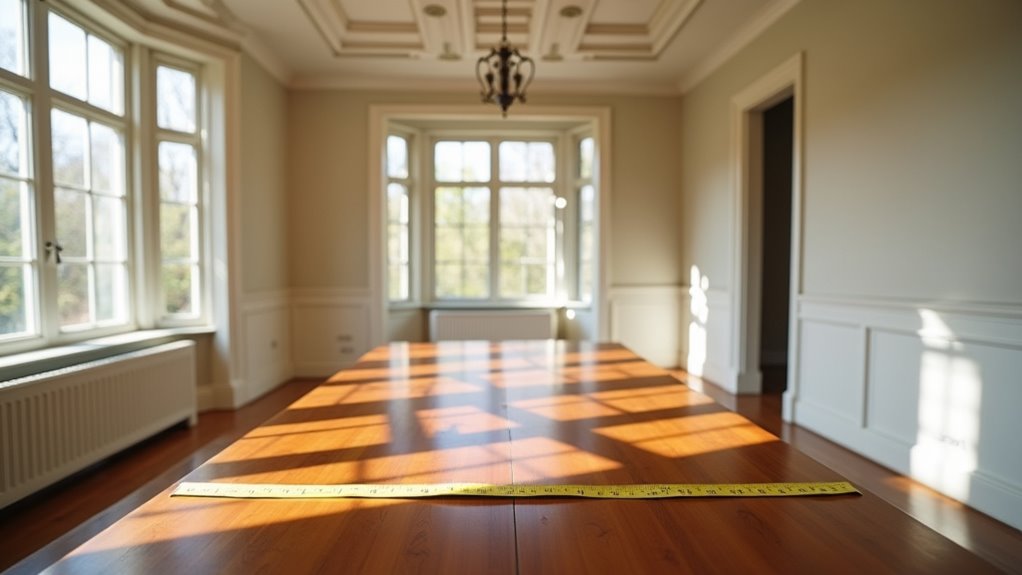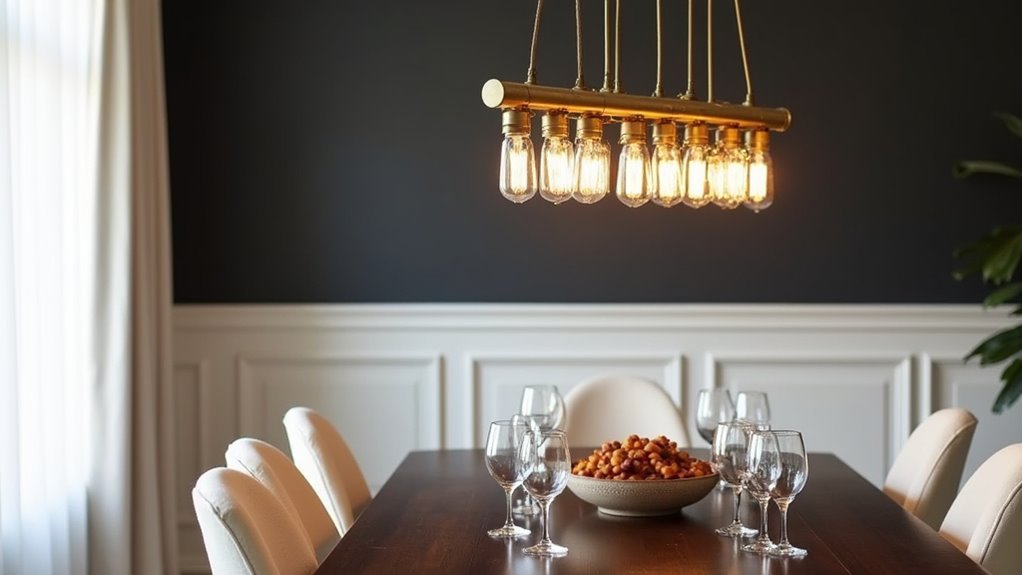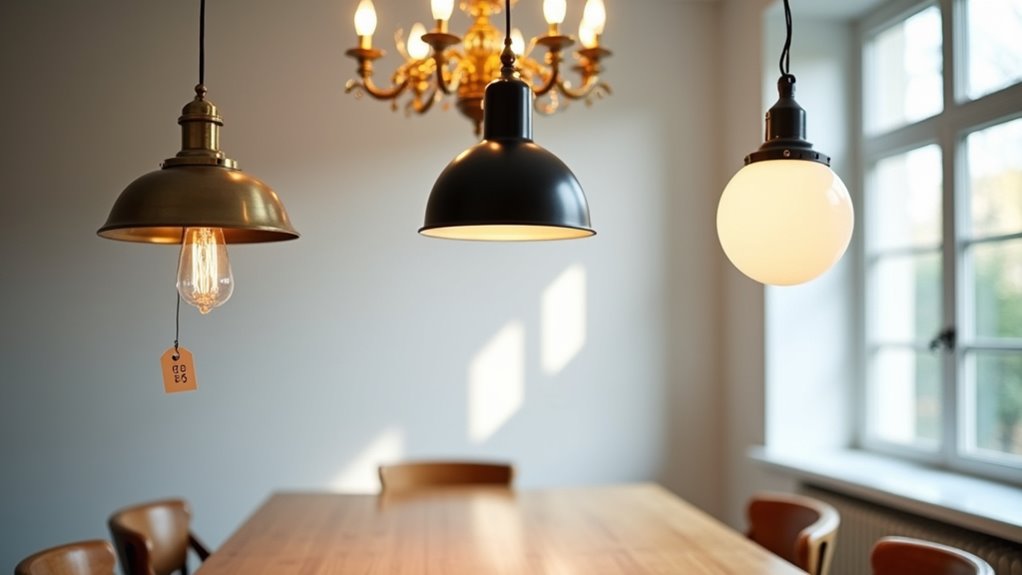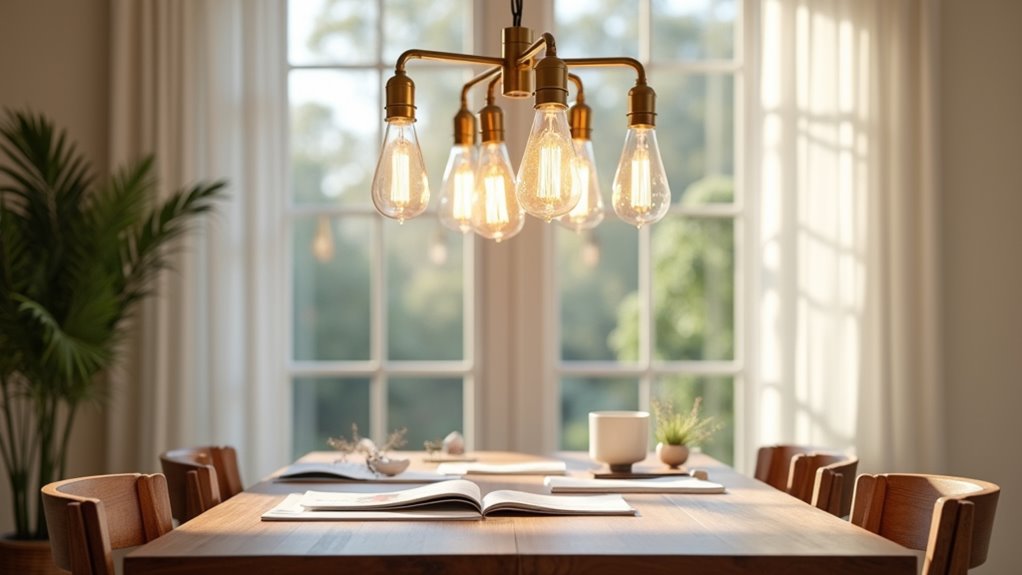Selecting the perfect dining room light fixture requires calculating proper dimensions by adding room length and width in feet, then converting to inches for fixture diameter. The chandelier should measure half to three-quarters of the table width, positioned 30-36 inches above the surface for optimal task lighting. Consider three lighting layers—ambient, task, and accent—while ensuring design compatibility through material selection and proportional relationships. Budget options range from $89-$133 across major retailers. Professional installation ensures structural support and code compliance for comprehensive lighting solutions.
Key Takeaways
- Calculate fixture diameter by adding room length and width in feet, then converting to inches for proper proportional sizing.
- Maintain 30-36 inches clearance between fixture bottom and table surface while ensuring central alignment over dining area.
- Choose warm color temperature lighting with dimmer controls to create flexible ambiance for various dining activities.
- Select style that complements room design, whether traditional crystal, modern minimalist, rustic, or transitional aesthetic approaches.
- Consider LED technology for energy efficiency and plan professional installation to ensure proper wiring and ceiling support.
Understanding Different Dining Room Lighting Styles

When selecting dining room lighting, understanding the distinct characteristics and applications of each fixture type ensures optimal integration with both aesthetic vision and functional requirements.
Chandelier variations encompass traditional crystal designs for formal spaces, rustic iterations for casual environments, and contemporary interpretations that bridge classical elegance with modern sensibilities.
Pendant styles range from singular statement pieces to grouped configurations, offering focused task illumination while accommodating diverse table geometries.
Linear suspensions deliver uniform light distribution across rectangular surfaces, incorporating LED technology for enhanced efficiency.
Modern minimalism emphasizes clean geometric forms and unadorned materials, creating visual restraint while maintaining functional performance. Many contemporary fixtures feature adjustable mechanisms that allow homeowners to tilt, pivot, or extend components for customized positioning. The fixture style should reflect personality and complement the home’s overall character to create a cohesive design aesthetic.
Transitional designs combine traditional luxury materials with contemporary architectural elements, featuring mixed metal accents like brass, copper, and blackened steel for sophisticated contrast.
Each approach generates distinct lighting textures, from the prismatic reflections of crystal elements to the directional beam patterns of focused pendants, enabling precise atmospheric control.
Assessing Your Room Size and Layout Requirements

Proper fixture selection requires precise spatial analysis that transforms aesthetic preferences into mathematically-informed decisions.
Room dimensions establish foundational parameters through a straightforward formula: combining length and width measurements in feet, then converting the sum to inches determines optimal fixture diameter. A 10×12-foot space requires a 22-inch fixture diameter.
Mathematical precision eliminates guesswork: add room length and width in feet, convert to inches for perfect fixture diameter every time.
Ceiling height modifications accommodate larger installations in elevated spaces while demanding flatter profiles in compressed environments.
Table proportions dictate chandelier scale, with fixture diameter ranging from half to three-quarters of table width. A 48-inch table necessitates 24-36 inch chandelier diameter.
Fixture clearance maintains 30-36 inches between table surface and fixture base, with 2-3 feet minimum wall clearance ensuring balanced visual weight.
Traffic flow analysis prevents obstruction while central alignment over dining surfaces optimizes both functionality and aesthetic symmetry.
Evaluating Your Lighting Needs and Functionality

Beyond dimensional calculations, functional requirements establish the operational framework that determines fixture performance and user experience.
Primary dining activities demand direct, sufficiently strong illumination concentrated on the table surface. Strategic fixture height placement, typically 30-36 inches above the tabletop, ensures optimal task lighting while preventing glare interference. Light intensity must balance brightness levels to eliminate shadows without creating harsh conditions that compromise visual comfort.
Implementing dimmer controls enables transitional functionality, allowing adjustment from high-intensity task lighting for activities to subdued ambiance for intimate dining occasions.
Effective functional design integrates three lighting layers: ambient foundation lighting, focused task illumination, and accent highlighting. Multiple pendant configurations or linear lamp arrangements accommodate rectangular table geometries, providing uniform light distribution.
Modern LED technology provides sustainable lighting solutions while delivering energy-efficient performance that reduces operational costs and environmental impact.
This layered approach transforms dining spaces into adaptable environments that respond to varying operational demands while maintaining consistent performance standards.
Considering Design Elements and Decor Compatibility

Design compatibility establishes the visual foundation that determines whether lighting fixtures enhance or detract from a dining room’s aesthetic cohesion. Achieving fixture harmony requires deliberate coordination between lighting materials, finishes, and architectural elements throughout the space.
Designers must evaluate proportion relationships, ensuring fixtures maintain appropriate scale relative to table dimensions and room volume. For round tables, fixtures should measure one-half to three-quarters of the table diameter, while rectangular surfaces benefit from linear configurations with six-inch clearances from edges.
Material selection directly impacts aesthetic balance, with finish coordination across hardware elements creating visual continuity. Warm color temperatures typically complement dining environments better than cool tones, while dimmable capabilities provide functional versatility.
Statement fixtures can serve as focal points when balanced with complementary accent lighting, establishing layered illumination that reinforces the intended design narrative. Proper fixture positioning requires centering the light over the dining table’s geometric midpoint and hanging it 30-36 inches above the table surface for optimal visual focus and functionality.
Exploring Budget Options and Available Choices

While design compatibility establishes aesthetic foundations, budget constraints significantly influence fixture selection and purchasing decisions within dining room lighting projects.
Budget options encompass diverse categories including chandeliers, pendant lighting, flush mounts, track systems, and wall sconces across price ranges from $89-$133 at major retailers like Walmart, Home Depot, and IKEA.
Affordable styles feature basic materials such as metal and plastic construction with simplified decorative elements, prioritizing functionality over ornate detailing.
Strategic purchasing considerations include bulb inclusion verification, installation complexity assessment, and seasonal promotional timing.
Entry-level fixtures demonstrate modern minimalism trends while maintaining essential lighting performance standards.
Multi-fixture combinations maximize spatial flexibility within constrained budgets, enabling layered illumination approaches that enhance dining room functionality without compromising design integrity or exceeding financial parameters.
Making Your Final Selection With Confidence

The culmination of dining room lighting selection requires systematic evaluation of proportional relationships, technical specifications, and aesthetic integration to ensure optimal fixture performance and visual harmony.
Final verification involves confirming dimensional calculations—fixture diameter matching room proportions and maintaining 30-36 inch clearance above table surfaces. Technical compatibility assessment includes electrical load capacity, dimmer synchronization with LED specifications, and structural weight support requirements.
Aesthetic coherence demands material finish coordination with existing metalwork and architectural elements throughout adjacent spaces.
Critical installation tips encompass professional consultation for ceiling reinforcement and complex wiring modifications. Fixture maintenance considerations should evaluate accessibility for cleaning procedures and bulb replacement logistics.
Shadow pattern analysis ensures even illumination distribution across dining surfaces. The selected fixture must demonstrate scalable design impact relative to room dimensions while providing functional task lighting and ambient atmosphere control through integrated dimming systems.






